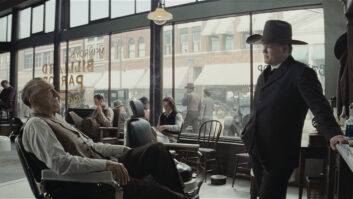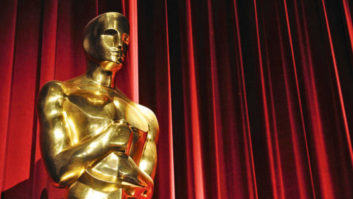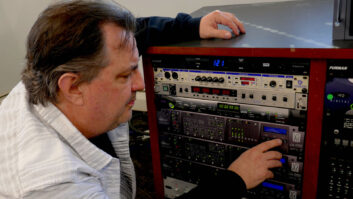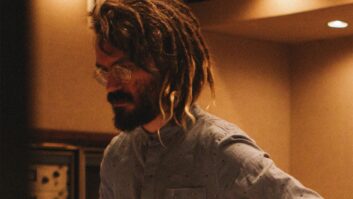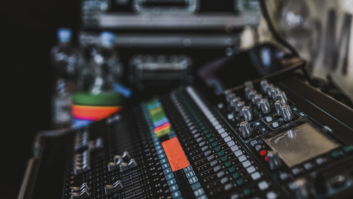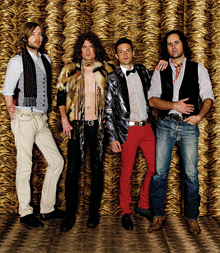
L-R: Mark Stoermer, Dave Keuning, Brandon Flowers and Ronnie Vannucci
Photo: Torey Mundkowsky
During one of the worst times ever in U.S. economic history, the reports of stock market nosedives, high unemployment and other gloomy events seem endless. But there is at least one positive outcome of all this mess. If it weren’t for our slowing recording industry and the real estate downturn, there wouldn’t have been a certain recording studio for sale in Las Vegas. And the celebrated rock foursome The Killers wouldn’t have bought said studio, nor would they have remodeled the place, bought a few pieces of equipment and turned it into Battle Born (www.myspace.com/studiof107), the recording home for their third studio album, Day & Age, released November 25 on Island Records.
The Vegas-based quartet — vocalist Brandon Flowers, guitarist Dave Keuning, bassist Mark Stoermer and drummer Ronnie Vannucci — had outgrown their barren rehearsal space and wanted a more comfortable place to prepare for their busy tour schedule, work through song ideas and, ideally, record them. “We were hoping to look into some of these foreclosures that were happening in some areas of Vegas,” says drummer Vannucci. “We wanted to find a home or a nice lot where we could make noise, but that didn’t really materialize. Then, on the very last day, the realtor says, ‘I know a guy that wants to sell his studio in central Vegas. It’s not listed yet, but I’m sure you can take a look.’” Ten minutes later, Vannucci was at the doorstep of Studio V (aka Studio Vegas), a mid-sized facility with two control rooms, a live room with two iso booths, a drum room and a decent stock of equipment, most of which could stay with its potential new owners. “I made an offer right then and there,” says Vannucci, “hoping the other guys would like it and I wouldn’t have to pay for it myself!”
With the paint dry and a newly purchased API 1608 console with 16-channel Expander installed, as well as pairs of Westlake BBSM-10s and Focal Twin 6s, The Killers could record their new album at their own studio without the tick of the clock counting down the billable hours. They had the freedom to experiment and re-record liberally; however, most of the time, they found that the first or second take was the best one.
Similarly, they followed their instincts when choosing Stuart Price to produce Day & Age. Price, an electronic musican/remixer/producer whose background includes remixes for No Doubt and Coldplay, as well as producing Madonna’s Confessions on a Dance Floor, had produced The Killers’ Grammy-nominated remix to “Mr. Brightside” and their 2007 Christmas single, “Don’t Shoot Me, Santa.” Although the band had only worked with Price as a remixer, they trusted the creative and personal chemistry at play.
“The Killers have a history of changing direction radically on each record,” says Price. “They recorded their first album very quickly — they were recording and mixing a song a day. They spent a lot more time and got a lot more in-depth in making the second record. So for this third record, I suppose they were equally interested in making it in a slightly more chaotic way, which would give rise to it being a little more of-the-moment. So it became an odd but interesting choice to have a remixer produce the record. They took a big risk, but that’s really the only way you can generate excitement.”
At the same time, Price, with his primarily electronic and dance-music background, took a risk when signing on to work with a rock band. “I always thought it would be great to make a rock record with remixer’s ideas,” says Price. “After doing The [Killers] remix, I was secretly hoping that they would be interested in working on an album. So the two ideas just married up really nicely. And I really think that’s what this album is — a rock record made with remixer’s ideas. That, for me, makes it new and groundbreaking.”
Trans-Atlantic Demo Recording
The Killers’ spontaneous approach to Day & Age came after months of preparation. Beginning in early ’08 after wrapping up their winter tour, each bandmember began coming up with song ideas, and then uploaded those ideas via e-mail and Apple iDisk accounts so that the rest of the band could build off of them. “We could add, change and shoot things back and forth this way,” says Vannucci. “We ended up with something like 50 ideas for songs, so when we did get into the rehearsal room, it was like, ‘Okay, let’s go down the list.’ Every idea saw the light of day.”
By late summer, they were ready to take the best of those ideas and turn them into songs. With Vannucci manning an Apple MacBook Pro equipped with Logic Pro 8, the band recorded rough versions of the songs and sent them to Price, who edited, rearranged and otherwise manipulated the tracks from his London studio. “Sometimes these demos would be re-arranged three or four times until we felt like we got it right,” says Vannucci.
“There are four prolific writers in the band, and sometimes all the song needed was someone to say, ‘What you’ve got in that verse is really exciting; maybe we can expand on that with this chorus idea,’” adds Price. “And from my studio I could be very objective because there was no one over my shoulder. I could work very honestly. And when I sent songs back to Ronnie or Brandon, they could be really objective, as well, about what was coming back. Somewhere in that international Internet language we found a way for the songs to evolve.”
The demo recordings evolved so well that about half of what you hear on Day & Age came from those sessions. By high-end recording standards, the tracks shouldn’t have worked. The band recorded in either their rehearsal space or their unfinished studio using only a Logic system and “budget” mics. Oftentimes Flowers would intend to record scratch vocals in the Battle Born control room with a Shure SM58, but they sounded too good to replace. The quality of the music transcended any perceived limitations of recording equipment and technique.
“Stu really liked the sounds that we were coming up with,” says Vannucci. “A lot of it couldn’t be duplicated — but we tried! There was no pressure, and sometimes it ended up sounding better than something more thought out or contrived. The tracks had this breath to them that was very easy, free and effortless.”
One- or two-take moments happened frequently, including on “Losing Touch,” where Keuning nailed a guitar solo. “Dave plugged in about eight bars before the solo came in,” says Vannucci. “I miked his cabinet with an SM57 and recorded a separate line out just from his guitar. I also had a dry signal where I would mess around with plug-ins. Dave had a pitch-shifting pedal that had kind of a ’70s harmony, and I was also getting that harmony on the dry signal. I ran the dry signal through an amp send and it sounded perfect for that song. So we ended up using it.”
The epic “Good Night Travel Well” features an on-the-spot drum pattern from Vannucci. “I caught a particular drum pattern and I wasn’t thinking about it; I was just letting it come out,” he says. “I listened back, and thought ‘Wow, this isn’t half bad, and it sounds good, too!’ I forwarded it to Stuart, and he loved the drum sound. When we got into the studio, we tried to go back and re-do those ideas, and it just didn’t work out the same.”
From his well-appointed London studio, Price fleshed out the arrangements and added parts of his own, including keyboards and other embellishments. His Apogee Symphony system with Logic Pro 8 includes an assortment of Universal Audio and VST plug-ins, which he uses with a vintage Neve Melbourne console, GML and Pultec EQs, UREI 1176 compressors, and Avalon and Neve mic pre’s, among other items.
For music creation, Price turned to his extensive analog synth collection, which he used liberally on the album’s lead single, “Human.” “The pads on that song came from an ARP Chroma [analog synth],” says Price. “We also used the Korg MS-20 and Nord Lead 3 quite a lot. A lot of the drums were processed through the external filter of the Korg MS20 because the old transistor distortion of that filter unit is very characteristic.”
Price also used the Korg SQ-10 analog sequencer — triggered by Vannucci’s kick drum — which would activate certain sounds from the MS-20. “On ‘Human,’ the rhythm is very rigid,” says Price. “I wanted Ronnie’s drums to sound like a machine, but I didn’t want to replace him with a machine because that would defeat the purpose of working with a band.”
Charging Ahead at Battle Born
By the time the band got into the studio — their studio — to track the album with Price and engineer Robert Root, they had a solid foundation. “When we first started rolling, we’d say, ‘Okay, what do we want to build off first?’” says Root. “Then we would get the next piece of the puzzle laid down. We decided on a song-by-song basis who was going to play and in what order. So it was similar to overdubbing rather than straight tracking, mostly because the demos had already been heard and manipulated in some way by Stuart before he came to town.”
For the parts that they did record, the band took a “less-is-more” approach, choosing a more sparse miking technique, especially on the drums, which Root spread out to only nine tracks. He miked Vannucci’s extensive Craviotto drum collection with an AKG D-112 or Audix D6 for the kick, Earthworks SR25 drum mic for overheads and a Royer R-122 for the center overhead in certain cases. Snare top was miked with a Josephson e22S, while snare bottom took a Shure SM57. Root used a Brauner VM1 with a UREI 1176 compressor for additional room sound. For a different type of response, he put the drum kit in the vocal booth.
Lacking a sub-kick microphone, Price created one using a technique borrowed from other recordists. “We found an old speaker cone in the studio, but it was a little too small so we took the two wires out of it and ran it into a mic channel so it was working backward,” says Price. “That’s what we used to create a lot of the low end coming from the kick drum. Since the speaker cone is so much bigger than the normal diaphragm on a microphone, it creates a really huge ‘subby’ sound.”
Despite its rickety design, the speaker cone mod worked well enough to also capture room ambience. “We’d use it in reverse and fire audio out of it back into the room and capture that sound from the other side of the room with a distant room mic,” says Price. Flowers’ vocals got a similar treatment. “If we thought that the vocal sound needed more body, we would take a speaker with a bass port and send the vocal through that, but with an SM58 right inside the bass port so it was really just picking up this sick bottom end. When you hear it back, you hear this muffled sound, but when you mix it in with his direct vocal, it added a lot of body.”
Experiments aside, most of the tracking sessions were pretty straightforward and efficient. Root recorded into Logic using the band’s new API 1608 with 16-channel extension — a lucky find. “We were going to try to get away with the Studer board that was already there, but it blew up two days into recording,” says Vannucci,“which is kind of good because I had my eye on the 1608. We threw in a couple of API 500 Series and Purple Audio compressors and bought a bunch of plug-ins to work inside the box.”
While the band recorded new parts to merge with the demo tracks, Price worked at a brisk pace embellishing tracks, re-arranging, editing and mixing, all pretty much simultaneously. “Sometimes when people aren’t sure if a song is there or not, they’ll say, ‘Well, it’s going to be good when it’s mixed.’ When you say that, sometimes you’re avoiding the real issue, which is, ‘Is the song good enough or not?’ I thought it would be nice to do these two things together. That involved me and Robert Root working very quickly and trying to mix as we went along. That way, if Dave was recording guitar and came back into the room to listen, we could have it already sitting in a track. So Robert and I would work in a very restricted way where we squeezed drum lines, bass, guitars, keys and vocals onto 16 channels on the API. Instead of separating the two processes, we brought the two together.”
Because Price had edited and partly mixed the album during the tracking sessions, the actual mixing sessions, which took place at London’s Olympic Studios, incorporated guitar, bass and a healthy amount of vocal overdubs. (Flowers originally sang many of the choruses before he had finished the rest of the lyrics.) Price mixed on the facility’s SSL 9000 K console, and as with the rest of the process they maintained a collaborative environment.
“The Killers are very active in every area of their career: their promotion, their music, their image,” says Price. “For that reason, it was good to not have any separation and for us to make the record as a unit. There is a certain amount of smoke and mirrors involved when you’re producing a record. Sometimes it’s advisable not to let people see [what’s behind] the smoke and mirrors, but I thought from day one that if everyone is there and sees what’s going on, no questions will be raised in the end. And I felt better that we were making an honest record that everyone had been a part of.”
Final mixes complete, Price delivered the album to esteemed mastering engineer Tim Young at London’s Metropolis Studios. “Tim is equally good at his job as he is unimpressed by anything,” Price says with a laugh. “So when he gives you the nod, you really know that it’s good. He thought about what was best for this album and decided to master it using all analog equipment.”
Excitement began to build well before Day & Age dropped on November 25, propelled by its lead single, “Human,” which debuted at Number 13 on Billboard‘s Modern Rock Tracks chart, a well-viewed appearance on Saturday Night Live and just the all-around anticipation from fans that have waited two years for some new Killers songs. And considering the attention the band, both as a unit and individually, has put into their songcraft this time around, it’s worth the wait. “They’re all very creative and have their own ideas and opinions, but when you get them all together, it’s like they know what each other is thinking before they say it,” says Root. “They’re very tight-knit. They act as one and think as one, but individually they’re all creative. They’re the quintessential rock band.”

